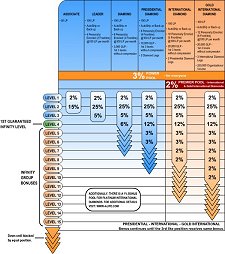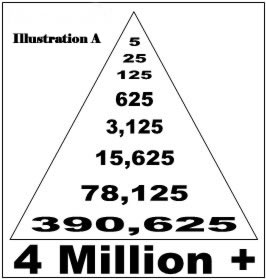|
Science Behind an Effective Pay
Plan
A Philosophical
and Historical Perspective of Compensation Strategy
by Mike Akins

The following
is an expository on the company compensation program and pay plan. During my career of more than three decades, I have found
that the majority of networkers do not understand the dynamics of compensation programs. This is not a reflection of
the individual's intelligence level but is due to the lack of statistical information available in our industry. I
employ a staff of statisticians who compile data for my use in marketing strategies. In order for you to understand the significance
of each feature in the company compensation program, I have included in this analysis an overview of industrial statistics,
marketing trends, historical precedents, the effect of present and past marketing philosophies, along with the fundamental
principles by which our industry functions. Only when you understand the dynamics that control results in this industry,
can you measure a pay plan effectively.

In order
to understand the merits of the company compensation program, you will need to understand the dynamics of "true" network marketing.
There are market forces and business principles that determine what works in this industry. Sometimes these factors
are not obvious but very subtle. For an example, our surveys revealed that, in the past 2-3 years, more than 2 million networkers
have been victims of failed network marketing programs. They were working against factors that they did not fully understand.
During this period, another 2 million have switched programs. A majority of these programs were flawed from their beginnings.
A great number of these individuals have repetitively made the same mistake in their selection. They simply do not have a
complete picture of what to look for in a viable program. Our research discovered that a number of these individuals left
viable (good) programs because they didn't know how to recognize or how to work a viable program. Again this is not due to
a lack of intelligence or skills on the behalf of the distributor, but the lack of statistical information and "trade specific"
training.

During my first eight years of network marketing I suffered
from identical circumstances. Repetitively, I would build only to lose. I was literally spinning my wheels. In this synopsis,
I will share what I have learned during my successful career of more than three decades in this industry. Also, I will share
information that I have obtained from Research & Marketing Consultants and ABM Marketing, which are statistically based
conventional firms that I own. These firms have studied the network marketing industry extensively. Recently, these firms
completed a study of more than 300 programs. Marketing trends, attrition factors, compensation strategies, product
philosophies, support strategies, growth patterns and many other issues were carefully researched. Now you, the networker,
can have the same statistical support that other industries have enjoyed for years.

Generally, when
a networker analyzes a program's potential to produce compensation, they look to the pay plan. In reality, it requires more
than a theoretically lucrative pay plan in order to produce adequate compensation. In network marketing, the equation for
success contains several factors. The pay plan is one of these factors. Each of these factors influences the effectiveness
of the other factors. For example, a great pay plan may not produce great paychecks because of inferior products or ineffective
marketing systems and strategies. A great product line may never produce great sales due to poor marketing strategies or lack
of pay incentives. A program with both quality products and a lucrative pay plan may fail to "fly" because of the company's
failure to keep up with the growth and provide quality service. A program can have certain strengths but contain weaknesses
that attract the wrong type of networker, causing stagnation and excessive attrition. A pay plan may be imbalanced, awarding
one segment of networkers at the expense of another.

The
purpose of this expository is to share general information on the dynamics of compensation and specific information on the
potential of the company program to produce compensation. I believe that the company pay plan is in the top 5% of pay plans
in the industry and is potentially the number one compensation producing opportunity in the industry. In order to capture
the full potential of this opportunity, there are certain dynamics you must be aware of that affect the ability of the program
to produce compensation for a broad base of its members.
In order
to determine the potential of a program to produce income you must understand the difference between a compensation plan and
a pay plan. A "paper" pay plan is primarily a schedule through which commissions and bonuses are theoretically paid. A
compensation program includes all factors that produce actual compensation. There are several factors that are important
to a program's potential to produce income that are not included in a pay plan. For example, a "hot" product or a toll-free
hotline may make it easier for distributors to enroll a greater number of prospects. These factors would be considered compensation
factors but not pay plan factors. You cannot determine the real potential of a program to generate income without understanding
the concepts and principles upon which the industry is founded. Your understanding of these fundamental principles will
affect the criteria by which you select a program and judge its potential. These factors determine which features will affect
actual compensation. Also, your marketing philosophy will affect your marketing strategy as well as influence your stamina,
which is vital to long-term success.

A pillar to success in network marketing is the geometric
growth factor. Understanding the principles that relate to geometric growth will assist you in selecting a viable program
and structuring your organization for long-term success. Because of the geometric growth factor, it is important to attract
a combination of the right types of networkers into your organization and place them correctly. This principle is called
tier structuring. I will expound on this principle later in this synopsis. One of these tiers consists of the end product
users. There must be individuals who are primarily interested in using the product, who are not interested in earning income
through the product. Without tier structuring, your program or organization is destined to fail in spite of how brilliant
you may be.
In order to understand
this principle explicitly, consider the following example: If you follow the geometric growth of a 500,000 member organization,
you will find that approximately 390,000 of these total distributors will be on the bottom level (see illustration A). In
traditionally structured programs, it requires at least 10-15 individuals purchasing product (equal to the qualifying dollar
amount) in order for one distributor to break even on their personal qualifying purchase and get into profit. In the highest
paying programs it will still require at least 4-6 purchasers. With either of these extreme approaches, there will always
be from 75-90% of all distributors not breaking even on personal qualifying purchases or earning a profit. It is vital to
your success to understand this principle. Failure to address this issue has been a major reason that a number of leaders
in the industry have not been able to maintain a consistent degree of success. They are always in a rebuilding mode.
 The difference between the
number of distributors earning a profit in the best paying program and the worst paying program is only about 15-20%. At
best, only 25% of your distributors will be earning a profit or breaking even on their qualifying product purchases. What
are the other 75% going to do? If they are networkers involved to make a profit, they will drop out. You cannot escape
this ratio. This dynamic is a foundational principle built into the very concept of network marketing. There has to be
end users who are not earning an income. The program that you are involved with has to be able to attract non-income earners.
In illustration A, in order for the 390,000 distributors to break even or earn a profit, they will have to find from 1˝ million
to 4 million new purchasers. Can you imagine what the requirements for the next level will be? A program will begin to unwind
from the bottom up when they reach this theoretical threshold illustrated above. Actually, this principle affects the unwinding
process very early in the building process. If you never understand anything else, it is vital to your success that you comprehend
this principle. In order for one person to break even or make a profit, there must be 4-6 people who do not! Write this down
on paper. Work through the figure over and over again, until you capture a vision of what I am sharing with you. This factor
must be considered when selecting a program.
 The unwinding process can
begin before an organization reaches this size. Small organizations of only a few hundred or a few thousand can experience
the unwinding process as they build. There are many factors that affect the growth and stability of an organization. These
forces are affecting the growth process from the beginning stages. Only when a majority of these factors work in unison,
can an organization experience solid growth that will last. Many times what creates explosive growth initially will be
the very factor that creates excessive attrition later. Certain strategies attract certain types of individuals. The type
of individuals your program attracts will, in part, determine the long-term attrition and retention rates. It is not a matter
of "good" or "bad" people. It is a matter of certain "mindsets" that respond to certain factors in a program. The features
that stand out in a program or that you primarily promote will attract networkers who value those particular features.
Each distributor's paradigm toward network marketing is shaped by their personal experiences, skill level, work habits, expectations,
personality traits, and their perspectives that have been influenced by the information they have been exposed to. This paradigm
will affect their performance and determine their value to your success. In emphasizing the wrong features, or selecting a
program that has misplaced priorities, you may attract an imbalance of a particular type of networker who will predispose
your organization to failure or a high attrition rate.

is important
for a network marketing organization to contain a balance of tier participants as well as a balance of the different types
of individuals. You can control this balance by selecting the right program, with the right features, and by promoting these
features correctly. A great number of networkers waste a tremendous amount of time promoting programs and features that
will defeat them in the long run. You can overly promote a positive feature and create the wrong expectations in your
distributors. For example, you may overly promote a system that could have been a support to the efforts of the marketer.
By over-emphasizing the system, the marketer fails to develop his skills because he depends on the system or support to
create success for him. You can overpromote a pay plan to the point that the marketer has unrealistic financial expectations.
The marketer may drop out because of these expectations, whereas, he may have stayed in the program and achieved success if
the program was promoted correctly.

The right program
promoted correctly will naturally build a strong organization. First, the program should have organizers, strategists, and foundational members. These
individuals influence overall company direction and strategy. Secondly, there must be senior and junior leaders who are the
"movers and shakers." These leaders provide "in the field" leadership and motivation. Next come the moderately experienced
networkers and part-timers that represent a broad range of income requirements from a few hundred dollars to a few thousand
dollars per month. This tier of marketers will actually do the majority of the sponsoring. Each will only enroll a few new
distributors, but as a group the numbers are significant. Other tiers will include product users, hobby enthusiasts, and customers
who are involved just for quality products or the social aspect. This group will be the product user base for the income earners
and should be the largest segment. The product user base, individuals who are either low or non-income earners, must constitute
at least 75% of your organization or eventually excess attrition will occur. This is based on the principle explained
in illustration A. Only when your organization contains all of these tiers do you have a secure residual income.
It doesn't matter
how lucrative the pay plan is, there must be a majority of individuals in the marketing structure that are primarily product
users. In examining illustration A, you can understand the need for this. These product users can be customers or members
who are primarily in the program to purchase the product at wholesale. A viable program must be able to attract product users
in order to create long-term compensation for the networker. The dynamics of a pay plan will not have a profound effect on
attracting or retaining these product users because they are primarily product-minded and not focused on income. Actually,
a program that is promoted primarily for the pay plan will have a difficult time attracting product users. When the money
is the main issue, earning expectations are higher. For the 80-90% who will be at the bottom of the matrix, these expectations
will result in discouragement and attrition. When a balance of features are promoted, "casual" part-time distributors that
may not, for a number of reasons, be "destined" to earn much income will stay as product users. The product line and service
will be the key factors in attracting and retaining product users. Also, the quality of service and a simple, "problem free"
ordering system will accommodate the retention of these product users. Designing the appropriate product and service strategies
is vital to a tier structured organization.

All of the "giants"
in the industry have been built according to the "tier structured" philosophy. That is why they have survived in spite of poor pay plans. Amway has
3 million distributors worldwide. With one of the worst pay plans in the industry, they have maintained a distributor base
of 2-3 million distributors for several years. How? There are many tiers of participants. Shaklee, Forever Living, NuSkin,
and HerbaLife are all billion-dollar companies, and each has developed on a tier structure of participants. Until you understand
this concept, you will not be able to develop strategy that will produce long-term results. Companies that have primarily
promoted the pay plan as the main commodity do not understand the basic principles upon which network marketing is based.
This is why they are not doing so well in the arena of competition. The pay plan is important, but it is only one of several
factors involved in producing maximum compensation and retention.

The purpose of pyramiding
laws is to protect innocent distributors from the consequences of the mathematical realities involved in geometric
growth. Legislators realize that you cannot build a secure networking business on only networkers who are each expecting to
earn an income. Legislators call this structure a "house of cards," which will collapse under its own weight. That is why
there must be end users who are not involved for an income. Just as in a conventional business, where you have general managers,
department managers, staff members, foremen, common laborers, and customers, in network marketing you must have various tiers
of marketers and product users. Network marketing will not function effectively any other way. Eventually, individuals
at the bottom of the pyramid will drop out initiating the unwinding process that will work its way up to the upper levels
of the structure.
As I shared
earlier, the equation for success contains several factors. The percentage of distributors who will achieve success in
any particular program is determined by these factors. A few of these factors include the security of the company, the
paradigm of the company leaders toward their distributors and the industry, effective marketing and compensation strategies,
the product philosophy, the potential of the products to retain product users, the support tools in place that accommodate
the "grassroots" networker (who may have limited experience and time), the type of training available and, of course, the
degree of personal effort invested by the networker (this can be influenced by what you promote). The strategic balance
of these factors will determine the amount of compensation produced by a program.

Company leaders must proportion
the proceeds between the various areas of operation. They must balance their investment between the following: the products,
packaging and marketing materials, product research & development, management salaries, salaries of service and support
personnel, investment returns, facility, equipment, commissions to distributors, and marketing support systems such as toll-free
hotlines, and Internet tools. A strategic balance of these investments is vital to long-term success. You must invest
in quality corporate leadership that can create the right strategies and provide the visionary leadership that will be best
for the overall opportunity. At the same time, the company must invest enough money into the compensation plan so marketers
can earn incomes that are competitive at various levels with programs within the same marketing arena. The competitive issue
here is not the theoretical pay plan but the actual incomes earned at various levels within the distributorship.
The pay plan
is one of the factors involved in producing compensation. There are two fundamental aspects of a pay plan that determine its effectiveness. First,
you have the structure of the pay plan. The breakaway, binary, matrix, Australian two-up, multiple phase, and the uni-level
are examples of the different pay structures available in the industry. Secondly, how the bonuses are appropriately placed
throughout these structures is important. Each of these structures have features that favor the heavy hitter, the company,
or the part-timer. Pay structures that balance the potential commissions between these three categories provide a more secure
income for all three. Traditionally, pay structures have favored the company and a few heavy hitters. Gradually, network marketing
is maturing and a number of programs are providing a better balance between these segments. In my personal opinion, I believe
the uni-level provides the greatest opportunity and balance for the majority of its participants. I will thoroughly expound
on the different pay structures in another expository at a later date.

When reviewing pay
plans, look for balance.
An effective pay plan should place a significant percentage of bonuses on the first two levels to support the less experienced
part-timer. A significant percentage of the commissions should be placed on the next couple of levels and into the infinity
bonuses to adequately compensate the moderate part-time to full-time marketer. There must be deeply penetrating bonuses to
sufficiently compensate the leaders. The bonuses at the beginners' levels should be easier to reach, while the bonuses at
higher levels must be protected by qualifications that restrict the number of individuals that can obtain them. If higher
levels are too easily reached, the experienced networker will be blocked from deep penetration and will migrate to another
program. Balance is the key to overall success. Imbalanced programs lead to attrition and failure. If too much money
is placed at the beginning levels, the program will attract an imbalance of inexperienced networkers. Without a sizable number
of experienced leaders who have previously achieved success, your organization will be weak. The marketing strategies and
training skills they bring to the program can be very important.
The largest
segment of part-timers and the least experienced networkers will benefit more from the first two levels. Within our industry,
there is a wide range of payout on these levels. Traditional programs generally pay 5-10% per level on these levels. Recently,
"compressed" pay plans have appeared in the market paying 15-50% on the first two levels. There are serious drawbacks to each
of these extreme positions. Smaller percentages up front create an unfavorable break-even ratio. Placing too much money in
the first two levels will attract a greater number of networkers who are more likely to drop out. Secondly, examine how many
levels are guaranteed. Traditional programs guarantee 5-7 levels. A program that guarantees more levels generally will pay
less per level. This will create a poor break-even ratio that can lead to higher attrition. Programs that pay too much
on the first couple of levels, generally include appropriate "breakage" and BV factors that disguise the true payout. These
programs "steal back" the misplaced percentages from other levels within the pay plan. The most effective pay plans will
balance the first two levels with deeper levels. A pay plan should allow the part-timer to get into profit with 4-6 purchasers.
There must be enough income available to the experienced networker in order to attract quality leadership into the program
and produce the type of checks that will hold them.
 When examining pay plans look for "breakage"
and BV features which affect true earnings. The term BV (sometimes referred to as CV, PV, and LP) ratio refers to the figure
from which you are actually paid in relationship to the actual cost of the product. The term breakage generally refers to
qualification requirements within the pay plan, which "not so obviously" affect the true payout of the program. In response
to competition, there is a trend toward offering high bonuses and then diluting these bonuses with low BV and excessive
breakage. In order to find the true bonus, divide the BV by the wholesale price. For example, a BV of $30 divided by the
wholesale cost of $40 gives you a 75% ratio. If the plan claims a 40% payout, multiply the 40% by 75% and you find that the
true payout is 30%. To discover how breakage affects true payout, find out what percentage of individuals can achieve that
bonus level. For example, if a bonus requires $50,000 volume to achieve, divide the $50,000 by the expected average purchase.
This will give you the total number of individuals required to reach that qualification. If the average purchase is $100,
in the above example, the $50,000 qualification will require 500 people to reach it. Overlap can be figured by dividing 500
by the width requirement

Once you carefully analyze
the pay plan and understand its theoretical potential, you will need to analyze the potential of other compensation features
to influence earnings and retain distributors. As I stated earlier, there are several factors other than the pay plan
that influence actual income potential. In order to clearly understand the balance between the dynamics that affect success
in network marketing, we must examine the history of our industry. History teaches us that a great majority of networkers
respond to products and other related factors before they consider the pay plan. This is a reality that must be addressed
in order to select a program that will produce residual income. Since 75% of a healthy organization will primarily be product
users, the fact that the majority of networkers are attracted to the product first is a healthy scenario. One such reality
is that products in network marketing have a tendency to cost more than products in the conventional market. In order to keep
product users, the company will have to offer unique products that are not easily duplicated in the conventional industry.
With the inevitable ratio of three out of every four networkers not breaking even on product purchases, a balanced product
and marketing strategy becomes vital to attracting enough product users to maintain success.
In reviewing
40 years of network marketing history, we find that the majority of successful programs are focused on the products and service.
Amway, Shaklee, NuSkin, and HerbaLife each have more than a million distributors and each have very poor pay plans, yet they
maintain the greatest number of active distributors. More recent "success stories," such as New Vision, Mannatech, and Morinda,
are product focused programs. Each of these three companies have exceeded all records for quick growth, enrolling more than
one-half million distributors within three years from being founded. Cell Tech and Life Plus, which were around awhile before
they "exploded," grew from 30,000 to 500,000 distributors in three years after finding a popular flagship product and an effective
marketing strategy. Both of these companies are product and service focused. All of these programs have pay plans that are
considered to be in the low to moderate-paying category. As you can see, the dynamics of growth are complex. The more you
understand about these dynamics the better you can develop strategy and select the program that will best fulfill your goals.
I am not promoting a poor pay plan, but I am using these examples to bring a sense of relativity to our perspectives.

A benefit to programs with pay plans in this
category, is that they attract individuals who seem to have a broader perspective of network marketing and will stay in a
program long enough to give it a chance to succeed. They generally do not have exaggerated expectations and know they have to learn how to work a program
to be successful. This type of networker is more likely to include product users in their recruiting efforts and interact
more with their downline, resulting in a more solid foundation. Even with poor pay plans, these nine programs have produced
more incomes and higher incomes than the "sum total" of all the other hundreds of programs in the industry. Amway alone
has produced 2200 millionaires. I agree that if they would have had more lucrative pay plans there would have been even
more successful "grassroots" distributors but, from these examples we can learn principles that can effect our futures.
These principles
must be taken into consideration when selecting a program. Pay plans do not attract the masses but are important once the
individual is involved. First, you must be able to attract the right type of prospects to your opportunity and then be able
to retain the distributors once they have joined your program. Pay plans are not the only factor that is involved in retention.
The majority of companies in the industry represent two extremes in compensation philosophies. The traditionally structured
programs place the majority of commissions outside the reach of the part-time distributor. The company and the more aggressive
networker benefit most from this imbalance. The other extreme is the "hyper compressed" pay plans. Our company represents
a middle ground between these two extremes.

Let's take a closer look at these compensation strategies
and learn from them. The traditional 5-10% paid five or six levels deep created a situation where it required 10-20 distributors
in each marketer's business to break even on qualifying purchases. Each new distributor that enrolled faced the same challenge.
Therefore, as the organization grew, the problem intensified. The result was more attrition at the "grassroots" level.
In spite of the flaws in the pay plans, these companies have produced a great amount of compensation. Because of certain other
compensation factors outside of the pay plan, these programs survived and are viable in today's markets. The company retained
enough product users and passive part-timers to support a number of successful serious networkers. These traditional companies
have been able to survive and thrive because they were product and service focused and were built on a tier structure. The
networkers with low skill levels, but with higher ambition, suffered in these programs. This is the segment that suffered
more attrition. Programs with more balance are finding more distributors at the beginning levels earning more income. A reaction to this imbalance is the compressed compensation pay
plan. In a compressed pay plan, the company places a greater percentage of the commissions within reach of the majority of
its members. Theoretically, this encourages a higher rate of retention. In order to understand the dynamics of these philosophies,
I invite you to read my synopsis, "Cold Facts Exposed." Typically, the compressed
pay plan will pay out, 30-50% (after adjustments for BV) within the first two levels. Traditional programs pay out a total
of 10-20% within the first two levels. Additional pay up front allows the part-time marketer to earn more with fewer people
in his downline. The inexperienced marketer will have more difficulty sponsoring other distributors and developing a customer
base. The first level is the least important level because you should have fewer people on your first level than on your second
and third levels. With the assistance of your first level distributors, you should have more marketers on your second level.
Occasionally, inexperienced networkers will desire more immediate income on their first level, but this is not wise. Whenever
you place more commissions on any particular level it must come from another level. It is best for the marketer to have the
commissions placed on the levels that are most likely to have more members, but still within reach of the part-timer

When compressed programs first appeared, they generally
paid 15% and 45% on the first two levels. Infinity bonuses started on the third level. Marketers were blocked too easily
in these early models and there was not enough incentive to build deep. Later models offer more guaranteed levels with
fewer blockages. Now that compressed pay plans have been around four to five years, challenges have surfaced. A majority
of companies that are using the compressed pay plans have overreacted to the traditional, flawed pay plans. Companies
that have gone too far in the compressed pay plan "paradigm switch" are experiencing slow growth and similar attrition
problems that the traditional pay plans have experienced. These companies are having difficulty attracting a great number
of experienced networkers who can bring to the company a wealth of wisdom and leadership. Many of these companies have over-invested
in the pay plans. This creates a shortage of funds, not allowing for investment in product research and development, state-of-the-art
service, competent leadership at all levels of corporate management, and effective support systems. The end result is inferior
products, a lack of innovative products, poor service, inadequate inventories, and the creation of a financial scenario that
sometimes threatens the company's survival. Our company offers a more moderately compressed program with potential for
deep penetration. It contains a better balance, allowing both the lower skilled marketer and the highly experienced leader
to benefit more evenly.
Observe
this principle at work. As I shared earlier in this synopsis, product focused companies, such as New Vision, Mannatech, Morinda,
Life Plus and Cell Tech, each grew to a distributor base of approximately 500,000+ within a period of 2 to 3 years. Each of
these programs has a very poor pay plan, averaging less than a 10% per level payout. Heritage Health, LifeForce, and Changes,
which represent "exaggerated" compressed pay plans, are growing at 1/10 the rate. LifeForce has, at one time or another,
had 80,000 distributors. In the spring of 1999 they had approximately $700,000 in monthly sales. If each active distributor
purchased from $50-$100 per month, that would translate to be only 10,000-14,000 total distributors in the company. The attrition
rate is high.

Although these
companies pay more money up front than traditional companies, they have similar attrition rates. Why? These programs place an imbalanced emphasis on income, which leads to exaggerated
expectations and excess attrition. They cannot attract, nor hold onto, the product user and other important tiers of participants
that form a solid foundation for networkers to succeed. As I have shared in this synopsis, theoretically, the majority
of participants in this industry cannot and will not earn a profit because of the geometric requirements for each individual
to earn income. In the right program, many of these participants will eventually become product users. In a program that offers
overpriced "me too" products, that can be purchased at a local discount store at lower prices, they will drop out. These
types of programs attract an imbalance of networkers who are only "income-minded" and have not developed the patience, the
understanding, or the skills (or even the willingness to develop the skills) in order to succeed in network marketing.
These networkers are looking for a pay plan or certain feature to make the difference in their success. Programs that attract
these types of marketers may produce short-range success for a few, but so far have not shown the ability to maintain that
success.
Programs that focus
on "easy money" instead of sound business principles attract a majority of individuals who are not realistic in their expectations
and do not have a realistic perception of their skill level. They will not be satisfied with the success that their skill level will produce. Generally, these programs attract
a greater number of disgruntled networkers who are skeptical and carry a low level of anger toward the industry. These
types of networkers become discouraged easily and will drop out of whatever program they select. These types of marketers
will lean on "self-propelled" systems that require very little of the individual. This approach robs the marketer of the experience
and training that is necessary for real lasting success. This segment of networkers has the highest rate of attrition in
spite of what the pay plan offers. The best approach for these networkers would be to select a program that is designed
on principles that have been proven to work over the past several decades, and learn how to market a viable program. Simply
put, "money focused" programs do not create more money for the majority of networkers or, in other words, "easy money" doesn't
come easy.

Product focused
distributors will generally stay in a program longer as they learn the "ropes" to success. Building a successful business
requires a process of personal growth, the maturing of strategy that is "program specific," cultivating the prospect market,
developing and test marketing various marketing tools that have a long-term benefit to the specific program, and the development
of a support structure that is tailored to the needs of your specific program. All of these factors are important to "real success" (success that is going to last). There is a current trend to
shop for a program that is going to "take off" for you. Sometimes the factors that create a short-term growth wave are the
very factors that destroy the "wave" later. History proves this concept to be true. During my career of more than three decades,
not one program or downline organization that has been built on the "money focus" approach has succeeded. I am in the industry
full-time to earn a very lucrative income, but I have earned this income by developing a solid organization founded on sound
business principles of being "product and service" oriented. There must be enough time allowed for a "tier structure" to develop
in your particular organization.
Aligning
your strategy with the principles of being product and service focused is a key to lasting success. Finding a true product
and service focused program can be difficult. There are three types of these companies. The first type of product focused
company is one that directs the attention of the distributors to the product, because they realize it gives their program
an image of legitimacy. The leaders believe that money is the real focus but realize that they may be perceived as being
a "money game," so they superficially promote a quality line of products or service. There is a wide range of "money focused"
programs in the industry, ranging from gifting plans, cycling plans, and one-time purchase programs to opportunities that
resemble a "true" product focused program. These types of programs do not have strong residual income potential and only produce
short-term growth.
 A second type of
product focused program places emphasis on the product and service, but does not provide effective features within the program
that support the success of that type of program. Product focus does not only refer to emphasis on products. It also refers to marketing strategy that provides marketing
features, along with the products and service that support tier structured growth. The majority of the time, this type
of program is using "sizzle" product propaganda to cover up a poor pay plan. This type of program may experience initial
growth only to level off as distributors experience the dynamics of the program.

The third type of
product focused company is one that actually designs the features of the program to naturally attract product focused distributors.
These programs will have higher quality products and generally have "flagship" products that are more cutting edge and exclusive.
These companies will provide marketing tools, state-of-the-art systems, effective literature, credible endorsements, comprehensive
customer service, and other features that target tier structuring. The end result is progressive growth and lasting success
at the distributor level.
There are
a number of individuals who have tried traditional programs and failed to earn an acceptable income. These individuals have
concluded that the programs didn't pay enough. To an extent, this is true. As I mentioned, a number of traditional companies
used the product focused philosophy to hide a poor pay plan. Traditional programs have a tendency to pay too little up front.
This does make it more difficult for the start-up part-timer. On the other hand, exaggerated compressed programs have used
the "up front" philosophy to hide inferior products or a poor marketing strategy. Remember the break-even ratios that I previously
shared in this synopsis. The programs that pay the highest up front still had 75% percent of their participants unable to
break even on their qualifying purchases. The traditional programs had a "break-even ratio" of 10/90%. The difference between
the two extremes is only 20%. We still have the minimum of 75% of the distributors dealing with the profit issue. Paying more
money up front is only part of the answer. Placing too much money up front only worsens the problem as I have already explained.
The answer is a balanced marketing plan, more effective training, better support, and tier structuring, which means bringing
more product users into the program.

Even the individual who has difficulty achieving success
in network marketing can be successful under certain conditions. They should join a program during its infancy that has the
type of products and strategy that will eventually attract and retain a great number of customers and product users. These
networkers must have the type of training available that will assist them in learning to become true networkers who progressively
develop their marketing skills. Programs that are seriously flawed encourage networkers to reach for "super systems"
and "gimmicks" to compensate for the flaws. Circumventing effective training through gimmicks will spell certain doom.
Initially, these tactics will create growth. This growth will be short-lived. Systems can be helpful but cannot generate enough
enrollments to create a large number of marketers successfully. A few heavy hitters will be the only ones that benefit from
a system alone. Without a viable program and the proper training, the cluster of "well wishers" will eventually perish. Achieving
and maintaining success requires participation from a majority of its participants. Success in networking marketing is based
on teamwork. Anyone who believes they can ride a system to success without working and learning how to effectively market
it, will find that success short-lived. Downlines must be nourished and "cultivated" or they will not last. Everyone
must learn to do his or her part. Systems are tools that do not stand alone but must be designed to compliment sound business
building techniques.
Once you
understand these principles, you will know what to look for in a program. Companies that have developed marketing strategies
that address each of these factors will become giants in our industry. There has been a tendency for traditionally structured
companies to neglect the pay plan factor. This has led to unnecessary attrition of networkers who could have otherwise been
successful. Many of the large traditional companies have addressed the other factors well enough to attract these multiple
tiers of participants. There has been a need for improved pay plans. Our company is a leader in this arena without compromising
the other vital components. Companies that have overreacted to this need and placed to much money into the pay plan have
done their distributors a disservice and produced inferior overall programs. Distributors in these "hyper-compressed" programs
are experiencing difficulty in building successful organizations.

During my career of more than three decades, I have developed
organizations in both traditional programs and compressed programs. I presently have approximately 75,000 in
existing downlines. In my first nine months, I have engineered the development of a 9,000-member organization in this company.
I selected this company because I believe it has achieved a balance between the two extremes. I find that the members in my
company organization are experiencing a greater degree of success than members in the other programs, both at the "grassroots"
and leadership levels. From a percentage perspective, we have more customers and product users in the company organization.
This is a very healthy scenario. "Grassroots" distributors are sponsoring more easily and the ones that are building correctly
(tier structuring), are experiencing success. The company program is packed with compensation factors to complement the
pay plan. These compensation factors allow the distributor to "leverage" the pay plan to the maximum extent. A compensation
factor is any feature in the program that assists the marketer in generating more income. I will explain the pay plan and
how it is synchronized with compensation features that make the company program very unique and positioned to be one of the
leaders in the industry.
|
